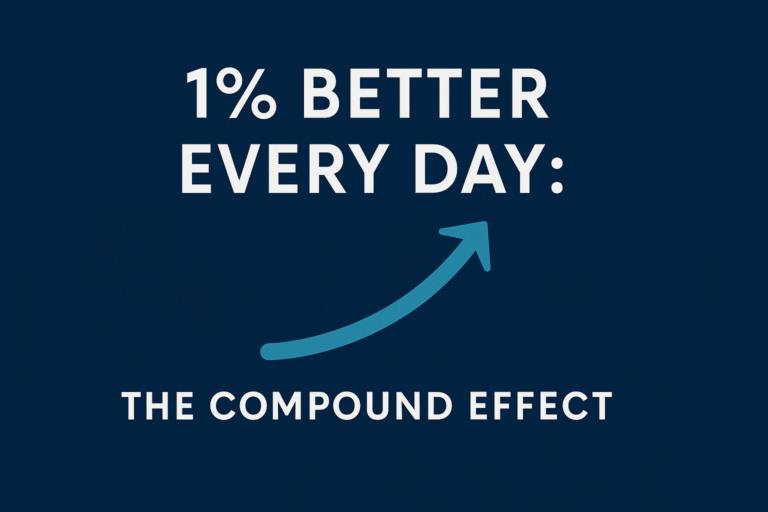“Show me your habits and I’ll show you your future.” – Mark Batterson
If you’re someone who has ever tried to start a new routine—whether it’s hitting the gym regularly, waking up earlier, or cutting out a bad habit—you’ve likely felt the frustration when things don’t stick as planned. The process of making a change of habit can feel like an uphill battle. Sometimes 2 steps forward and 1 step back. But why is it so hard for us to embrace change of habit, even when we know it’s good for us?
In this article, we’ll dive into the reasons why changing habits can feel almost impossible and discuss ways to overcome these challenges to achieve lasting change.
What Is a Habit and Why Are They So Hard to Change?
How Habits Are Formed
Habits are automatic behaviors we’ve developed through repetition. Our brain creates neural pathways to help us perform tasks without constantly thinking about them, saving mental energy. Think of brushing your teeth or checking your phone when you wake up; these are examples of deeply ingrained habits that have become almost second nature. Our brains love routine, why? Because it is a form of certainty.
Habits follow a simple three-step loop: cue, routine, and reward. In The Power of Habit by Charles Duhigg, he explains how these steps work together to reinforce our behaviors. For example, if you feel stressed (cue), you might reach for a snack (routine) and feel a temporary relief (reward). Each time this loop is repeated, it becomes more solidified.
Why Change Is So Hard
The reason it’s so difficult to break a habit or form a new one is that our brains resist change. When we try to create a change of habit, we’re disrupting a well-formed neural pathway, which can feel uncomfortable and even exhausting. Our brains want to conserve energy, so they’ll naturally gravitate toward the path of least resistance—our already established habits.
Willpower Isn’t Enough
The Limits of Willpower
When it comes to changing habits, most people believe that it’s all about willpower. But relying on willpower alone is often a setup for failure. Studies have shown that willpower is like a muscle; it can become fatigued over time, a phenomenon known as decision fatigue (Baumeister & Tierney, 2011). This is why sticking to a new habit may feel easy at the start of the day but challenging by the end.
We all make new years resolutions and the most common: going to the gym. When I first tried to make a habit of exercising every morning, I realized my motivation was strong in the beginning but began to fade as the days passed. I’d feel energized for the first week, but by the second week, I’d find excuses to skip my routine. This is where I learned that it’s not just about initial motivation—it’s about having a plan that keeps you going even when your willpower is low. This makes the difference between those who succeed and those who don’t.
The Role of Your Comfort Zone
Our brains are naturally drawn to comfort and predictability. When you start a new habit or attempt to change an old one, you’re stepping out of this comfort zone, which feels risky and uncertain. The habit loop provides stability, and breaking it is often met with internal resistance.
Breaking Down Barriers to Habit Change
Start Small for Lasting Change
One of the biggest mistakes people make is trying to overhaul everything at once. For example, if you’re looking to exercise more, it’s tempting to dive into a full workout regimen immediately. However, research suggests that starting with smaller changes is far more sustainable. Behavioral scientist BJ Fogg suggests focusing on “tiny habits”—small, simple behaviors that can easily fit into your existing routine. He also states that it takes 21 days to change a habit and around 66 days to form it as part of our routine and identity. So consistency is the key.
In my experience, starting small was a game-changer. When I wanted to read more, I started with just five minutes before bed instead of committing to an entire chapter. This small shift made the habit feel manageable, and over time, I naturally started reading more as it became part of my routine. Pretty soon our brains recognize this as standard and will create time for us to make it happen.
Also best practice is to also accustom our brains to change. A great example of this is if you take a normal driving route to get to work or school, take a different one. If you have multiple bathrooms in your home take a shower in another. May seem odd or uncomfortable at first but with time making these small changes will accustom your brain to embrace change.
Understand Triggers and Rewards
Understanding the cue-routine-reward loop is essential for changing habits. This is the game changer! Identify the triggers that initiate your behavior and the rewards that reinforce it. For instance, if you’re trying to cut down on snacking, identify what triggers the habit. Is it stress? Boredom? Then, find a replacement routine that offers a similar reward, like going for a walk or practicing deep breathing when you feel the urge.
Overcoming Setbacks
Change is never linear, and setbacks are part of the process. It’s easy to feel discouraged when you slip up, but remember that each failure is a learning experience. Reflect on what led to the setback and adjust your approach. Self-compassion is critical; being too hard on yourself can lead to a cycle of discouragement and quitting.
Proven Strategies for Lasting Change
Habit Stacking: Hack to Changing a Habit
One of the best ways to introduce a new habit is through habit stacking, a strategy recommended by James Clear in Atomic Habits. Habit stacking involves pairing a new habit with an existing one. For instance, if you want to meditate each morning, stack it with an established habit like brushing your teeth. This tactic leverages the power of existing routines to anchor new habits.
Accountability and Support
Support systems can make a world of difference when you’re working on a change of habit. Whether it’s a friend, mentor, or accountability group, having people who support your goals can help you stay motivated and committed. In fact, research shows that people are more likely to stick to habits when they have social support (Armitage & Conner, 2000).
Celebrate Small Wins
Acknowledging your progress, no matter how small, helps reinforce positive behavior. Each time you hit a milestone, take a moment to celebrate. This could be as simple as acknowledging your progress with a friend or treating yourself to something small. Celebrating these wins creates a positive feedback loop that makes the habit change feel rewarding.
How to Maintain a Change of Habit Long-Term
Embrace the Process, Not Just the Outcome
One of the biggest shifts you can make is focusing on the process rather than the outcome. When you’re only fixated on results, you’re more likely to feel discouraged if things don’t go perfectly. But if you learn to value the journey, you’re more likely to stay motivated. Each day you commit to a new behavior, you’re strengthening your resolve and building momentum.
Build Resilience Through Self-Reflection
Setbacks will happen, but resilience is about learning to bounce back. Regularly reflecting on your progress can help you understand what’s working and what needs adjustment. Journaling or tracking your habits can help you notice patterns, which you can then use to make changes as needed.
Recognize That Change Is a Journey
Changing habits is an ongoing process, and there’s no “quick fix.” Building sustainable habits takes time, patience, and self-compassion. If you focus on steady progress and allow yourself to adjust along the way, you’ll be much more likely to make a change that lasts.
Conclusion: Why Change of Habit Is Worth the Effort
Changing habits is hard, but the rewards make the journey worthwhile. By understanding why habits form and acknowledging the psychological hurdles involved, you can approach change in a way that feels more manageable. Remember, every small step you take brings you closer to the person you want to become. Embrace the journey, learn from the setbacks, and celebrate each step forward.
If you’re looking to change a habit, don’t aim for perfection—aim for progress. Over time, these small shifts will add up, transforming not only your habits but also your outlook on life. We’re here to support you and also join the Permission Free Living community for inspiration from others!
References
- Baumeister, R. F., & Tierney, J. (2011). Willpower: Rediscovering the Greatest Human Strength. Penguin Press.
- Duhigg, C. (2012). The Power of Habit: Why We Do What We Do in Life and Business. Random House.
- Clear, J. (2018). Atomic Habits: An Easy & Proven Way to Build Good Habits & Break Bad Ones. Avery.
- Armitage, C. J., & Conner, M. (2000). Social support and behaviour change: A systematic review.





